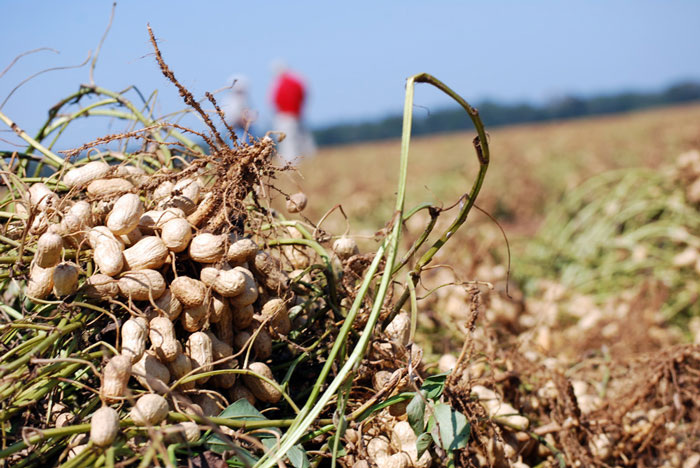April 26, 2016

The fungicide propiconazole, sold under tradenames Tilt, PropiMax and Bumper, has been used to fight leaf spot diseases in peanuts for years. Unfortunately, use of propiconazole and products containing propiconazole, including Tilt/Bravo, Echo-PropiMax, Stratego and Artisan, is in doubt for 2016.
Policymakers within the European Union have decided the methodology used years ago to determine maximum residue limits, or MRL, for propiconazole is inappropriate today; therefore, those levels are no longer valid.
Very likely most peanut farmers have used propiconazole at some point or other in their disease management program.
Most commonly, propiconazole has been mixed with chlorothalonil for a fungicide combination that offers both protectant and curative properties. Several premix fungicides have been available, including Tilt/Bravo and Echo/PropiMax. Propiconazole has also been paired with trifloxystrobin to produce Stratego and is a component of Artisan (propiconazole + flutolanil).
There is no suspected new risk from using this product. It is simply a change in the procedure used to determine propiconazole residues in treated peanuts. Until the required data can be generated using the new procedure, and a reasonable MRL established, the current MRL has been changed to a very low level. This raises the prospect that use of propiconazole at labelled rates could (theoretically) result in residues above this very low MRL. This could lead to the rejection of those lots of peanuts.
Growers should understand the current situation is NOT based upon increased concern for the safety of propiconazole and that the products containing propiconazole remain legal and labeled for use in the United States. The problem is not for use here; the problem lies in sale of peanuts treated with propiconazole to the European Union.
For the latest on southwest agriculture, please check out Southwest Farm Press Daily and receive the latest news right to your inbox.
SALE SUSPENDED
Syngenta Crop Protection is suspending sale of propiconazole on peanuts (Tilt/Bravo) until the situation is rectified. Syngenta is committed to steps required to update the MRL for Tilt to meet the requirements from the EU, though this requires a significant cost. Within the peanut industry, some of largest peanut shellers are now requiring that growers agree not use products containing propiconazole on peanuts that will be purchased by them.
European Union is also rejecting peanuts where residues of phosphorous acid/phosphite fungicides can be detected. Growers combating pythium pod rot have often turned to “phosphite” fungicides like K-Phite and PROPHYT to manage this disease.
Phosphite fungicides are considered very safe, so safe in fact that no maximum residue levels have been required by the EPA in the United States. However, this lack of established MRLs has resulted in problems in the European Union where policymakers have decided that residue levels need to be documented, and appropriate MRLs established. Since these data are not available, they have set very low MRLs .
Until the data can be generated to support a change to higher levels, any use of phosphites on peanuts would likely result in residue levels exceeding this MRL. As with propiconazole, shellers within the U.S. peanut industry are notifying farmers that they will not accept peanuts treated with phosphite fungicides.
EFFECTIVE OPTIONS AVAILABLE
The labeled use of products containing propiconazole and phosphite fungicides is both efficacious and safe. This could lead to frustration in the U.S. peanut industry given the stand taken by the European Union on peanut imports. However, to insure continued sale of American peanuts to our European customers we, as an industry, must find the best ways to meet the residue requirements.
What alternatives do growers have if they can’t use propiconazole or phosphite fungicides in 2016? The good news is that the “sky” is not falling; there are a number of effective options available!
The only soilborne/white mold fungicide affected by the propiconazole issue has been Artisan. Artisan is a premix of flutolanil and propiconazole. Growers can easily replace Artisan in their disease management program by selecting Convoy (flutolanil) and spiking with an appropriate leaf spot material. Use of Convoy maintains the efficacy of the flutolanil chemistry and adds flexibility in choice of leaf spot fungicide.
Phosphite/phosphorous acid-fungicides have been the “products of choice” for management of Pythium pod rot. If growers are a not allowed to use a phosphite for control of this disease, mefanoxam (Ridomil Gold) and perhpas azoxystrobin (Abound and generics) can be used to fight Pythium pod rot.
Below are alternatives for use of Tilt/Bravo.
Growers can replace Tilt/Bravo with Bravo (1 pt/A) + Alto (5.5 fl oz/A). The active ingredient in Alto is cyproconazole.
Growers can replace Tilt/Bravo with chlorothalonil (1 pt/A) and Eminent (7.2 fl oz/A). The active ingredient in Eminent is tetraconazole; tetraconazole, unlike tebuconazole, is not active against soilborne diseases.
Growers can replace Tilt/Bravo with chlorothalonil (1 pt/A) and Topsin-M (5-10 fl oz/A). Note: a tank-mix of chlorothalonil + Topsin-M should not be used more than twice per season.
Growers can replace Tilt/Bravo with chlorothalonil (1 pt/A) and Topguard (7-14 fl oz/A). The active ingredient in Topguard is flutriafol.
Growers can replace two early-season applications of Tilt/Bravo with a single application of Priaxor (6 fl oz/A) at approximately 40 days after planting.
Growers can cautiously replace Tilt/Bravo with Absolute (3.5 fl oz/A). Absolute is a premix of trifloxystrobin and tebuconazole.
You May Also Like




